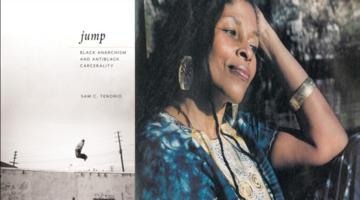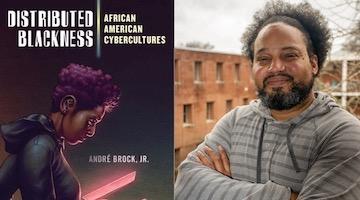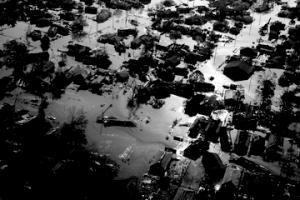Facial masks and Black Lives Matter murals are part of the ever-changing panorama that shapes our perceptions of hierarchy, just as tall buildings do.
“Our habits and patterns for seeing and knowing race are not timeless but taught; not transcendental but developed within the specific environments we navigate.”
In this series, we ask acclaimed authors to answer five questions about their book. This week’s featured author is Adrienne Brown. Brown is Associate Professor of English at the University of Chicago. Her book is The Black Skyscraper: Architecture and the Perception of Race.
Roberto Sirvent: How can your book help BAR readers understand the current political and social climate?
Adrienne Brown: A central argument of The Black Skyscraper is that race is always shaped in some way by the built environment. While my book largely focuses on how the early skyscraper in the first decades of its existence in the late 19th and early 20th century disrupted how people thought they knew and could read race from bodies, the book uses this test case to make larger claims for how we think about the built environment’s relationship to race in any period. Our habits and patterns for seeing and knowing race are not timeless but taught; not transcendental but developed within the specific environments we navigate. As built environments change, so do the measures of race, a fact that should encourage us to think about race in more site-specific terms—not only attending to national and regional contexts but studying the more immediate types of spatial landscapes that condition racial experience.
Indeed, recent events, especially the COVID-19 pandemic and ongoing police violence against Black Americans and communities emblematized by the murders of George Floyd, Breonna Taylor, and others point to enduring entanglements of racial perception, racial hierarchies, and the material environment. These yoked catastrophes of health and policing, which have disproportionately devastated Black and Brown communities, shape and have been shaped by the physical contexts in which these crises unfold. From the racialized effects of density during the pandemic, to how the wearing of masks disrupts or heightens acts of racial perception, and the oversized calligraphy declaring “Black Lives Matter” and “Defund the Police” drawn on a growing number of streets all foreground the ways that the material world in which we live in shapes the ways we literally and metaphorically navigate racial hierarchies and racial perception.
What do you hope activists and community organizers will take away from reading your book?
To never stop questioning what race is, how it works, and how we think we know it while nonetheless pursuing the eradication of white supremacy and anti-blackness. These dual projects of questioning race’s biological and perceptual fictions while seeking to destroy systems of racism that continue to depend on these fictions of race for their operation anchor the work of the black writers I study in the book. For instance, I spend a lot of time with W.E.B. Du Bois’ speculative stories about skyscrapers from the early 20th century. In these series of fictional experiments, Du Bois uses tall buildings to make processes of racial identification and racial affiliation become strange and unfamiliar in order to reimagine a different kind of perceptual and political world. While many white writers in this period worried that the changing scales, vantage points, and densities intensified by the skyscraper were making it harder to stabilize racial identification—since everyone looks like black specks from the top of the skyscraper—Du Bois instead used the visual effects of these buildings to ask, what disruptive purpose might we put the perceptual strains and disruptions caused by the vertical city?
Often, these experiments fail in Du Bois’ fiction—the skyscraper’s disruptive aspects cannot fully disrupt the mechanics of white supremacy that often snap back into place at the story’s end. But, in line with his theory of double consciousness, Du Bois never stopped thinking about the ways perception always shapes how we both know race and feel raced and understood politics to be connected to feeling and sight. Du Bois’ commitment to wildly reimagining the conditions of the present as they could disrupt habits of racial sight and power while also fiercely resisting the status quo is an approach I continue to learn from.
We know readers will learn a lot from your book, but what do you hope readers will un-learn? In other words, is there a particular ideology you’re hoping to dismantle?
To stop taking for granted our habits and patterns of racial perception and to dwell in how strange processes of racial identification and perception actually are. We tend to talk about racial perception as an instantaneous act—you know it when you see it, you decide someone’s race without thinking too much about that act of perception and judgment. But racial perception is better understood as a complex series of procedures involving judgment, reading, rationalization, and conjecture that normally go undescribed. I use the term racial perception in the book to mark the varying combinations of techniques, processes, structures, and convictions that allow a subject to believe they are having an experience of race. To quote scholar Nicole Fleetwood, “seeing race is not a transparent act; it is itself a doing.” To point out the constructed and relative nature of racial perception is not to diminish its power or its effects. It is, rather, to mark this “doing’s” capacity for adaption and transformation in order to consistently deliver race despite race’s immateriality.
Because racial perception is rarely taught in any explicit fashion but is acquired through socialization and habit, its operations tend to be concealed from us. For these reasons, processes of racial perception tend to become most visible in their breach—when something goes wrong, or you can’t quite classify someone. I’m interested in these moments of ambiguity, of pause and hesitation—when the environment gets in the way of our perceptual habits. Not because I think we can “unlearn” to see race—that’s largely a dead end given how entrenched racial hierarchies are in systems operating in excess of individual perception—but because these moments of unease allows us to better understand how much we rely on habits of racial sight to organize the world around us, both as individuals and through the systems we create.
Who are the intellectual heroes that inspire your work?
W.E.B. Du Bois and Nella Larsen who feature in the book continue to haunt just about everything I write. Both of these thinkers were so adept at raising questions about racial sight and racial feeling, again not to “debunk” these modes of knowledge but to try to push them to their limits to see what liberatory possibilities might open as a result and what might be a dead end.
This book would not exist without a host of scholars insisting that architectural history and theory engage more seriously and more studiously with critical race studies and the history of racial formation. Architectural history and theory has been notoriously belated to thinking about the ways race shapes the built environment and vice versa and this book builds on the work of Mabel Wilson, Dianne Harris, Charles Davis, William Gleason, Anne Cheng, and others to foreground architecture’s reliance on black bodies, racial theories, and racial capitalism to conceive of, describe, and carry out the work of building.
In what way does your book help us imagine new worlds?
As a humanist, I’m always fascinated by imagination—how writers are always imagining new worlds even when they claim to be painstakingly describing the real. Architecture is also committed to the literal building of new worlds. Thinking about how the act of physically building new worlds via architecture inherently changes how we think and know race and can reimagine racial worlds is at the heart of The Black Skyscraper’s mission. So I guess the answer is that the book helps us imagine new worlds by paying close attention to the work of imagining that is always going on in not just fictional works but theories of architecture and science that are just as reliant on racial imaginaries.
Roberto Sirvent is Professor of Political and Social Ethics at Hope International University in Fullerton, CA, and an Affiliate Scholar at Yale University’s Interdisciplinary Center for Bioethics, where he directs the Race, Bioethics, and Public Health Project. He is co-author, with fellow BAR contributor Danny Haiphong, of the book, American Exceptionalism and American Innocence: A People’s History of Fake News—From the Revolutionary War to the War on Terror.
COMMENTS?
Please join the conversation on Black Agenda Report's Facebook page at http://facebook.com/blackagendareport
Or, you can comment by emailing us at comments@blackagendareport.com



















